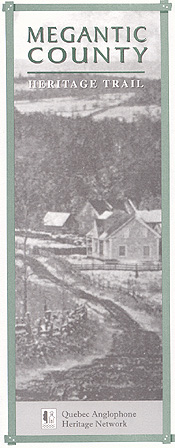
The Megantic County Heritage Trail leads to historic settlements and points of interest in rolling Appalachian country west of Quebec’s Chaudière River.
British immigrants poured into Quebec City by the shipload in the late 1800s. Most headed for Upper Canada and the U.S, but many Scottish and Irish pioneers followed the Craig’s Road to the timbered highlands in the townships of Inverness, Leeds and Ireland townships.
The Gosford Road, ten miles to the north, gave rise to Inverness and Maple Grove (now Bernierville). Many settlements in between live on in memory alone: Wilson’s Mills and Campbell’s Corner to name but two.
Colonists and their descendants built a way of life based on farming, forestry and later,
mining. Today’s travelers can glimpse the past in village churches and pioneer burial grounds that dot the region’s back roads. Local heritage groups in Kinnear’s Mills, St-Jacques-de-Leeds and Inverness offer summer walking tours.
GETTING THERE
From Quebec City, take Autoroute 20 west to Exit 305 and drive south along Rte. 269 to
St-Jacques-de-Leeds. This highway traces a section of the old Craig’s Road. From Montreal, take Autoroute 20 east to exit 228. Drive south on Rte. 165 to Princeville, then north on Rte. 116 toward Plessisville. Rte. 267 leads to Inverness, where it crosses the historic Gosford Road.
 Visitors may wish to purchase a guide to Protestant cemeteries from the Megantic County Historical Society. The Society uses proceeds from the sale of these guides to tend burial sites that would otherwise be neglected. Contact Society president Mildred Robinson, (418) 453-2247.
Visitors may wish to purchase a guide to Protestant cemeteries from the Megantic County Historical Society. The Society uses proceeds from the sale of these guides to tend burial sites that would otherwise be neglected. Contact Society president Mildred Robinson, (418) 453-2247.
OLD STAGE COACH INN
A few kilometres north of St-Jacques-de-Leeds stands a remnant of the Wilson’s Mills settlement: a remarkable fieldstone house recalling the early days of stage-coach travel between Quebec City and Boston. Built on a stretch of the Craig’s Road about 1835, the house belonged to the Palmer family — mill operators and innkeepers who gave their name to a nearby stream. For many years, the building also housed the village post office. It’s now a private home.
ST-JACQUES-DE-LEEDS (Leeds)
(Population: 900)
Archibald MacLean from Scotland’s Isle of Mull settled first in the Township of Leeds in 1809.
St. James Anglican Church, founded by Rev. James Alexander and built in 1831, is the oldest Anglican site in the province south of Quebec City. An adjacent rectory, built in 1837, has been restored and decorated in period furnishings. In summer, guides in 19th-century costume recall a time when Leeds prospered as a bustling hub on a busy road.
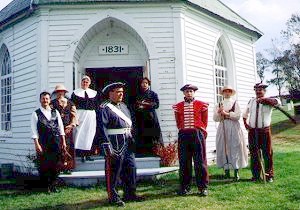 Anglo-Protestant heritage sites include well-kept Methodist and Anglican cemeteries and two historic rural school houses. South on the old Craig’s Road (Rte. 269) toward Kinnear’s Mills, the Trail passes a small Baptist cemetery.
Anglo-Protestant heritage sites include well-kept Methodist and Anglican cemeteries and two historic rural school houses. South on the old Craig’s Road (Rte. 269) toward Kinnear’s Mills, the Trail passes a small Baptist cemetery.
Leeds Model School, built in 1896, serves as the village Heritage Centre and as a backdrop for summer antique and craft shows. Call to learn more about special activities or stop by to arrange a walking tour.
Corporation du patrimoine du Canton de Leeds (418) 424-0212 or (418) 332-4642.
KINNEAR’S MILLS
(Population: 400)
Few places evoke the past like Kinnear’s Mills, with its bell-towers and weathercocks rising out of a wooded hollow. An interesting blend of colonial church styles moved Quebec to grant the hamlet official status as an historic site in 1980.
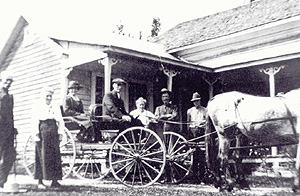 Kinnear’s Mills grew up around water-powered grain and timber mills that Scots pioneer John Lambie built on the Osgood River in the 1820s. The hamlet is named for James Kinnear, Lambie’s nephew who eventually took over the mills. Kinnear’s English-born wife, Harriet Wilson, started the settlement’s first general store in 1847, carting flour, eggs and cheese to Quebec in a horse-drawn buggy to trade for such staples as spices, sugar and cloth. By the end of the 1800s, the village had three stores, three churches, a hotel and a cheese factory — the centre of a thriving farming community.
Kinnear’s Mills grew up around water-powered grain and timber mills that Scots pioneer John Lambie built on the Osgood River in the 1820s. The hamlet is named for James Kinnear, Lambie’s nephew who eventually took over the mills. Kinnear’s English-born wife, Harriet Wilson, started the settlement’s first general store in 1847, carting flour, eggs and cheese to Quebec in a horse-drawn buggy to trade for such staples as spices, sugar and cloth. By the end of the 1800s, the village had three stores, three churches, a hotel and a cheese factory — the centre of a thriving farming community.
Early Methodists and Presbyterians held regular religious services in a little log chapel as far back as the 1840s before erecting churches of their own.
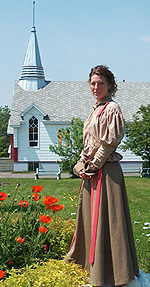 Candlish United Church, formerly Presbyterian, was built in 1873; the old Methodist Church, in 1876. Along with St. Mark’s Anglican (1897) and the Catholic Church (1950), these buildings figure prominently in the village’s built heritage.
Candlish United Church, formerly Presbyterian, was built in 1873; the old Methodist Church, in 1876. Along with St. Mark’s Anglican (1897) and the Catholic Church (1950), these buildings figure prominently in the village’s built heritage.
Travelers can learn more about local pioneer history by visiting the Heritage Centre in the old Methodist Church.
Heritage Kinnear’s Mills: (418) 424-3377
LIPSEY’S HILL LOOKOUT
(Elevation: 480 metres)
The top of Lipsey’s Hill, west of Kinnear’s Mills on the old Craig’s Road (Rte. 216), offers a spectacular view of the Appalachian countryside. On a clear day you can see as far as Quebec City. An interpretation panel here gives details (in French) about the history of the Craig’s Road.
A bit further along this road toward St-Jean-de-Brébeuf, on the south side, travelers will find a cairn marking the former site of a Wesleyan Methodist chapel, built in 1852, and its well-kept cemetery.
EARLY TOWNSHIPS ROADS
James Henry Craig, Governor of Lower Canada, built the first road linking Quebec City and the Eastern Townships in 1810. It took 180 soldiers three months to cut a path through 120 km of woods and swamp from St. Gilles to Richmond. There it joined a pioneer road south along the St. Francis River. The “Craig’s Road” made travel possible by stage coach between Quebec and Boston. But its upkeep was neglected after the War of 1812. In 1829, the road was declared unfit. The new governor, Archibald Acheson, Count of Gosford, authorized a new road from St. Gilles to Sherbrooke through Inverness, Maple Grove and the townships of Ham and Dusdwell. The “Gosford Road” was eventually completed in 1843.
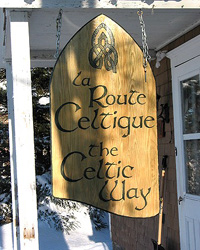 ST-JEAN-DE-BRÉBEUF (Lower Ireland)
ST-JEAN-DE-BRÉBEUF (Lower Ireland)
Anglicans built the first village church in 1839. In 1885, the church was rebuilt and renamed Christ Church. The Christie House, a fine fieldstone building just south of the village on the Craig’s Road (Rte. 216), was built around 1840 as an inn for stagecoach travelers.
INVERNESS
Irishman William Bennet came to Inverness Township in 1819, but the first colony dates to 1829 with the arrival of 12 families from the Isle of Arran, Scotland. Their descendants built two churches in the village: St. Andrew’s Presbyterian (1862) and the old Methodist Church (1862), now a bronze foundry. The Anglican church (1882) was moved to Inverness in 1925 from Campbell’s Corner, an abandoned settlement. La route Celtique heritage group provides guided tours and a map of historic Inverness township.
The Inverness Bronze Museum is housed in the historic Megantic County Court House, built in 1861.
Inverness Bronze Museum:
(418) 453-2101 La route Celtique:
La route Celtique:
(418) 453-3434
RECTORY HILL
All that’s left of this once-thriving colony on the 11th Range Road is the church (St. Stephen’s Anglican), the minister’s house and a graveyard. The current owners open the church to the public in summer and give details about the hamlet’s history in English and French. Appointments preferred.
Call Marie-Eve Adam: (418) 453-3434
LYSANDER FALLS
At the Lysander Falls rest area, stop for a picnic along the banks of the Bécancour River. A quiet stream in summer, the river swells to a torrent during the yearly thaw. Three covered bridges in the region were swept away and six men drowned during the flood of 1896. Read the marker erected in their memory.
A few kilometres north on the Gosford Road a covered bridge spans the river. The bridge was built in 1937 and is 33 metres in length. It is classified as an historic monument.
The Heritage Trail series is presented by the Quebec Anglophone Heritage Network, funded jointly by the Department of Canadian Heritage and Economic Development Canada. Space constraints preclude mention of all possible sites. Thanks to Joy Nugent of the Megantic County Historical Society for her help. For more information call the QAHN office at (819) 564-9595 or toll free within Quebec at 1 (877) 964-0409.![]()
![]()